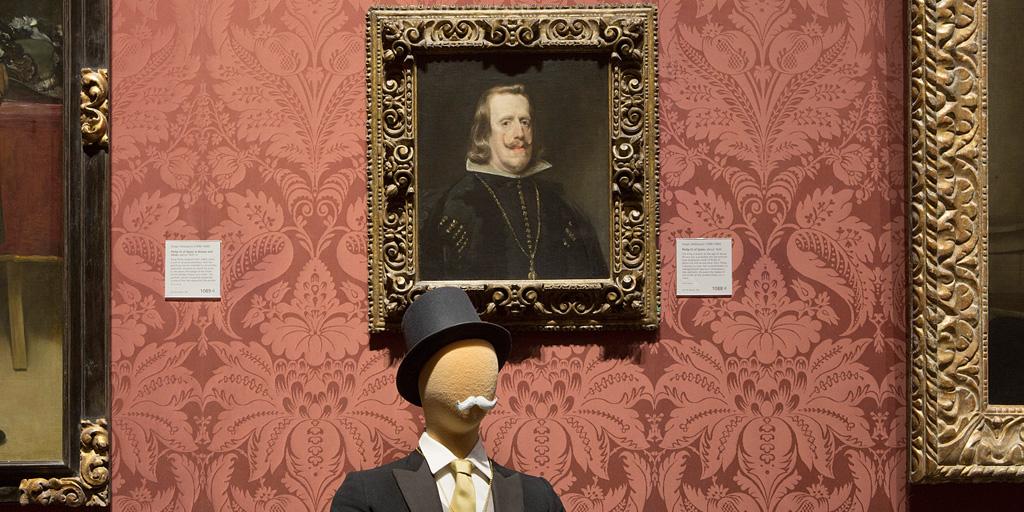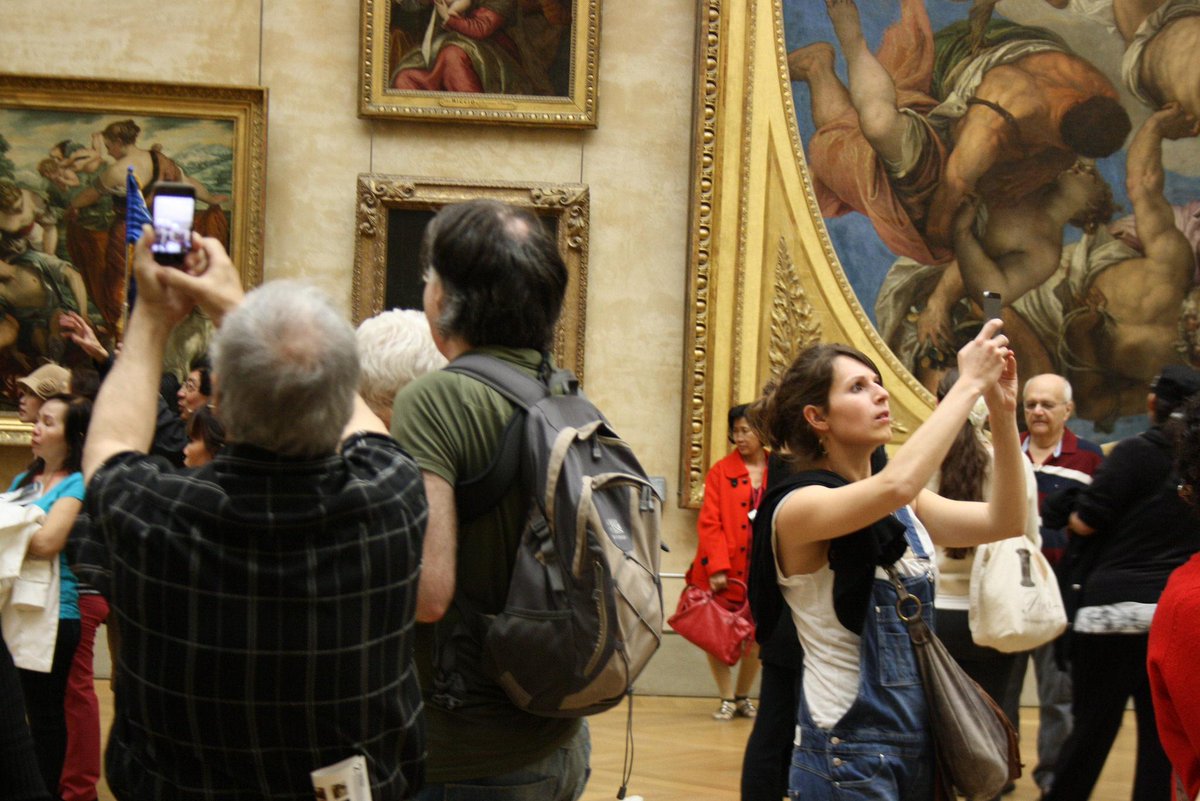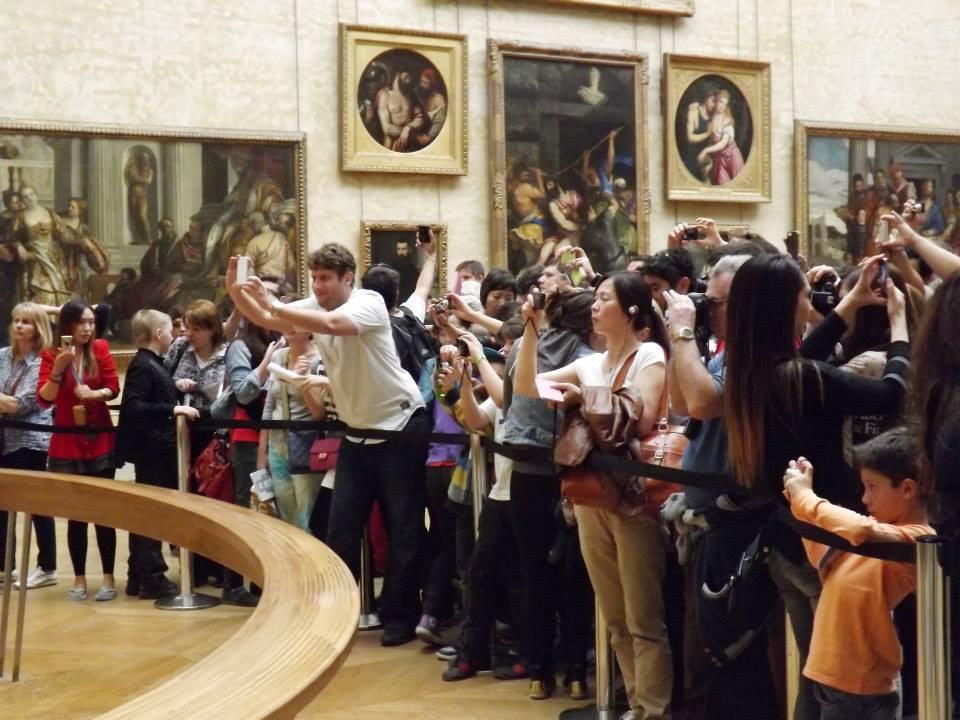 |
| Picture: National Gallery |
Sunday was 'pose day'. It's part of museum week, a Twitter initiative that encourages people to pose for selfies in front of works of art, striking a pose that imitates or reflects the art. Some people think it encourages new audiences, and others think it's harmless fun. But I think it's degrading to all concerned, reducing works of art to props and reducing museums to foils for people to brand themselves. I discussed it with CBC this week, but here are some more elaborated reflections.
There is something deadening about seeing crowds lining up to take their pictures in the same pose in front of the same work of art, rarely pausing to look at the backdrop. A picture that might embody the highest religious ideals or the profoundest philosophical thought, or simply the apogee of artistic technique, is cheapened when treated as an opportunity for a cheap visual joke. The National Gallery even took pictures of mannequins in front of pictures from its collection (above). It's a daft stunt that trivialises the art. And the visitors themselves are missing out. If they slow down and look they could start to understand why some works of art are appreciated as masterpieces.
Some works of art reward close study of technique. Others - the greatest - are transcendent and inspirational. It's thrilling to stand before a late Rembrandt or a great Poussin; they represent the highest level of individual human achievement. Unlike modern medicine and science, technology and industry, great works of art embody the creative spirit of a single person, however much they rely on learned technique or reflect their times. Going to art galleries is a chance to step outside our own humdrum concerns and be inspired, to seek to understand ideas that are sometimes alien and to engage with the mind of the creator. For some that inspiration is technical - how was this painted, and by whom? For others it might be more historical, or spiritual. Appreciation isn't automatic; rewards are proportionate to effort, and often requires guidance. But instead of guidance, museums offer cheap gimmicks like selfies and 'pose day'.
The impetus for all this nonsense doesn't come from patrons. It's being pushed by museums themselves, which now frown on lofty sentiments about art. They seek to make it as much as possible about us, and to bring it down to the must mundane level. They are absolving themselves of the responsibility to explain, offering instead cheap commoditised fun. The curators themselves have devoted their lives to studying art; they must surely think it's worthwhile. They understand what makes a picture great. But the highlights are now flaunted as nothing more than photo opportunities, tokens of high culture that flatter the selfie-taker.
At one level it ceases to matter whether a picture is even authentic if it's just to be used as background. But at another level I think it does matter to patrons; they do go to museums hoping to participate in a cultural experience. It matters that the backdrop has been identified as a masterpiece, even if they don't know why it has been designated great. The promoters of 'pose day' are cheating them. They are offering a pretend shortcut that requires no effort, but which equally offers no real reward. Promoting pose day shows contempt for visitors, substituting a simulacrum for the actual experience of engaging with art. The visitors leave with a cute photo, but no new knowledge or insight.
 The icon of all that's worst about the modern museum is the image of photo-wielding crowds in front of the Mona Lisa. But now even this is turned around and presented as virtue. These pictures were tweeted by the Louvre itself, celebrating the idea that a picture can be like a celebrity. Rather than see this impoverished experience for what it is, we are told to enjoy it as if we are taking the role of the paparazzi. Playing at being a celebrity photographer is elevated as the highest ideal of the modern commodified museum visit.
The icon of all that's worst about the modern museum is the image of photo-wielding crowds in front of the Mona Lisa. But now even this is turned around and presented as virtue. These pictures were tweeted by the Louvre itself, celebrating the idea that a picture can be like a celebrity. Rather than see this impoverished experience for what it is, we are told to enjoy it as if we are taking the role of the paparazzi. Playing at being a celebrity photographer is elevated as the highest ideal of the modern commodified museum visit. 
While I think these observations do have some validity, I also think it simplifies the visitor profile to one group as a whole. I think things like pose day, selfie day, and the various other activities encourages those visitors who would not normally come to a museum or gallery, see them as boring, or are the ones who aren't really paying attention at all, to come in, slow down (even if it's just enough to snap a good selfie- meaning they need to look at the work long enough to frame it), and show that museums can be fun and worthwhile. I have been to many a museum where I've seen visitors rushing though galleries with a video camera or just snapping random photos on their iphone- they're not even stopping to take the selfie, let alone contemplate and marvel at human achievement.
ReplyDeleteDays like this also don't necessarily discourage other types of visits- the guided docent tour, curatorial talk, audio tour, conference, workshop, etc. Those still continue; museum visitors who have always been visitors, considerers, contemplaters, will continue to do so.
These two types of visitors also don't have to be separate. I could spend hours and hours in a museum, contemplating art, admiring skill and achievement, but a funny selfie might still pop up here and there- that doesn't mean I haven't enjoyed, devoured, read every label, listened to the audio tour- I have. But I can have fun with the art too!
Museums have days and events like this to bring in new audiences, perhaps inspire deeper learning in new visitors who have just come to the museum and are inspired to learn more after they've taken their selfie or posed, and offer experiences on multiple levels. It doesn't have to be one or the other.
What a total misunderstanding of the purpose of the museum. It is not a „fun place”, not a romper room or hall of distorting mirrors. Bringing smart-phones to take yet more snap-shots of your marvelous Self is almost disqualifying as blindness[or more-because willful donkification is worse]
DeleteMalignant notion that it is good to bring in more and more wrong people is going to turn them into high culture lovers is not supported by any facts. It is the “midnight-basketball for ghetto thugs” way of thinking. Leave smart-phone crowd alone: they are evolving in a different direction and Occidental Heritage of Culture has only one use, they found: funny background as Michael writes. At a nearby library most seats in the Reading Room are taken but the occupants are taking extended naps, use restroom to body-wash, have speedy sex and over time I have never noticed that they started perusing the aisles for reading material.The painters exhibiting their masterpieces at the NG have not addressed their works to those selfie-ninnies.The curators,the management furnished them with wrong audience ,hostile to Culture. What a dismaying betrayal.
I think it's unfortunate you feel that way. Museums exist for the purpose of making art and artifacts, and history, available to the public. Many were explicitly established for that purpose, and continue to be free and open. I would argue that they are akin to schools and libraries- public places for learning and exposure to culture, and everyone should have access.
DeleteAnd how selfish to say that they are only meant for one type of person, that there could never be converts, or that you lump all of the 'smart phone crowd' into one group that couldn't love culture and art. At this point, I know very few people who don't own a smartphone, or aren't on at least one social media platform. Indeed, many directors, curators, and other museum staff have instagram accounts, facebook accounts, youtube, etc, and use them to give great additional insight into their work behind the scenes, or favourite pieces.
There is no reason that the two- culture and technology- cannot exist together. The world isn't divided only into high culture lovers and ghetto thugs who take selfies- there are many types of people, and who really fits into a category; who only has one interest? Technology has also allowed for huge additional opportunity for research and interpretation. For example, there's only so much you can fit on a text label, but you can fit infinitely more on a piece of technology- for example the interactive panels in the reconstructed rooms at the Met in New York, giving the opportunity to learn more information about each additional piece of furniture and art. Smart phones can also contain a variety of apps that increase interpretation and learning- from simply additional information to virtual reality apps to guided tours.
I also think it's interesting that you say 'the painters exhibiting their masterpieces have not addressed their works to those selfie-ninnies.' Many of them have not been addressed to any sort of public at all, cultured or not. Many of those great masterpieces had been commissioned for certain private audiences with a specific purpose- think marriage portraits, personal altarpieces, and timeless other masterpieces. They've all been removed from their original context and put into the museum, so now why distinguish that audience- none of us are the original audience. If a person has the desire to come in and see those works, placed in the public forum of the museum, then who are you to say no, or filter people based on pre-existing knowledge of art and culture, saying they are the 'wrong' people? Why wouldn't you want to encourage as many people as possible to see these great works, even if it's not in the same way you personally experience them? I would argue that any exposure is better than no exposure, and even if it inspires only ONE more person to learn more, then that's still one more person.
And there still exist many opportunities to have those strictly cultural experiences. Behind the scenes tours, members only events, workshops, guided tours, audio tours, conferences, publications, courses. All of these still exist.
Thank you for your thoughtful critique. I agree on several points; you're right that the division of visitors isn't absolute. But I'd like to see evidence for the 'gateway drug' theory. I don't think getting people to take selfies is a step towards greater enthusiasm, and I don't think that's the agenda of selfie day, which I think is treated as an end in itself. Also, I think you underestimate the degree of imposition on other visitors. Just look at the responses to online articles about cameras in museums; they make me look well-adjusted! Obviously self selecting, but still meaningful, I think.
Delete"But instead of guidance, museums offer cheap gimmicks like selfies and 'pose day'."
ReplyDeleteHow about, "In addition to guidance," rather than instead of? You make it sound like we've fired all of our curators and hired a collection of carnival barkers to take their place. It's possible to offer multiple kinds of experience. This isn't a zero sum game where somebody wins at the expense of everyone else. Selfie day isn't every day.
Not everyone who shows up is going to want the same thing, and not everyone we should be welcoming is going to behave the same way. That's culture. That's what human society looks like, and it's what art is actually about. Our collections aren't just rooms full of things. They're the physical artifacts of our shared cultural heritage. They're connections to other people.
Trying to structure our interactions with that cultural legacy in one and only one way is demeaning to the human experience that museums are supposed to represent and preserve. Yes, that means sometimes a visitor (or an artwork, or a selfie day) will annoy some people. The reverent art expert annoys people, too. The popular image of museums as "institutions" of high culture—inaccessible to the masses of brutish plebs unless they dust themselves off first and promise to behave—does far more damage to our actual mission as organizations than the one day a year where people get to act a little goofy.
I will be the last person to claim that museums are flawless or that they never take missteps, but the biggest mistake any *cultural* organization could make is to refuse to engage with people on their own cultural terms. Selfies are part of today's culture, for better or worse. Ignoring that isn't enlightened and uplifting. It's just one more way to isolate ourselves from a constituency that's already about as isolated from museums as it has ever been, primarily because they fear what is or is not permissible in an environment that already feels alien and imposing to them. Will selfie day work as the "gateway drug"? I don't know. But I know what doesn't work. It's what we've been doing for decades. That doesn't work. It's slowly killing us, isolating us further and further from the changing communities we're supposed to serve. So we're trying different things (not all of them selfie days). We have to.
And we still have all of the other programs that we had before. We still have the artist lectures, the docent-led tours, the catalogs, the research, the symposia and everything else you associate with a museum. Opening one door doesn't have to close another. And having these culturally disparate groups of people encounter each other in a reflective context once in a while might actually be a good thing, if they could just stop being annoyed with each other for a minute or two.
I agree! Well-said. 'In addition to' I think, is a great way to think about things like this.
DeleteI think opening this 'door' is actually closing other doors. I think you're far too sanguine. You can't say it's OK for people to chat through a classical concert, and then reassure people that they can also enjoy a quiet experience. In some museums, the lunatics really have taken over. Wall text is dumbed down, noise insisted upon, and people are expect to stand aside for selfie takers. I've been asked to move aside, and I've heard lots of other reports too. People assume that museums are there only to take a few snaps, and looking is seen as eccentric in some cases. People unfamiliar with museums are looking for guidance about how to behave, and they pick up on the culture created by pose day.
ReplyDeleteYou talk about isolation, yet visitor numbers rise inexorably. I think pose day is the kiss of death. It tries to convince people that museums are nothing special; they're just places to hang out and use social media. That's a pretty weak justification. And it won't build audiences.
'In addition' sounds nice, but it's just not the reality.
This comment has been removed by the author.
ReplyDeleteTo be clear: museum is not primarily to educate but to hold public display of select masterpieces. Education should happen before and after one goes to visit a museum. Nobody is listening to a symphony while someone is "explaining" or even eating with running commentary. Do one or the other, not both at the same time. Looking at paintings requires immersion in the same kind of silence and concentrated attentiveness in which language of painting is silently eloquent. Too much is made of the '"explanations" of artworks and not enough emphasis put on contemplation. My contemporaries not only see on the screen the action but they want to be told that "Tyrone passed the ball to Leroy". Then they have to be told what the Prez in his speech actually said and what they see while staring distractedly at art.
ReplyDeleteI can see that readers of Michael's blog are devout democrats and therefore want more people at the museums and more often, bringing their children, perhaps even their pets to take some spontaneous snap-shots with them .Anything but increasing chances at concentration and silence.
My experience of the Mona Lisa pre-dates smart phones. But there were just as many cameras crowding around the painting. It was a frustrating experience. Here was your one opportunity to try to experience the painting first hand and people were trying to photograph it by itself (get a poster) or with poses (get a life). (You were in Paris at the same time, I believe, Michael)
ReplyDelete